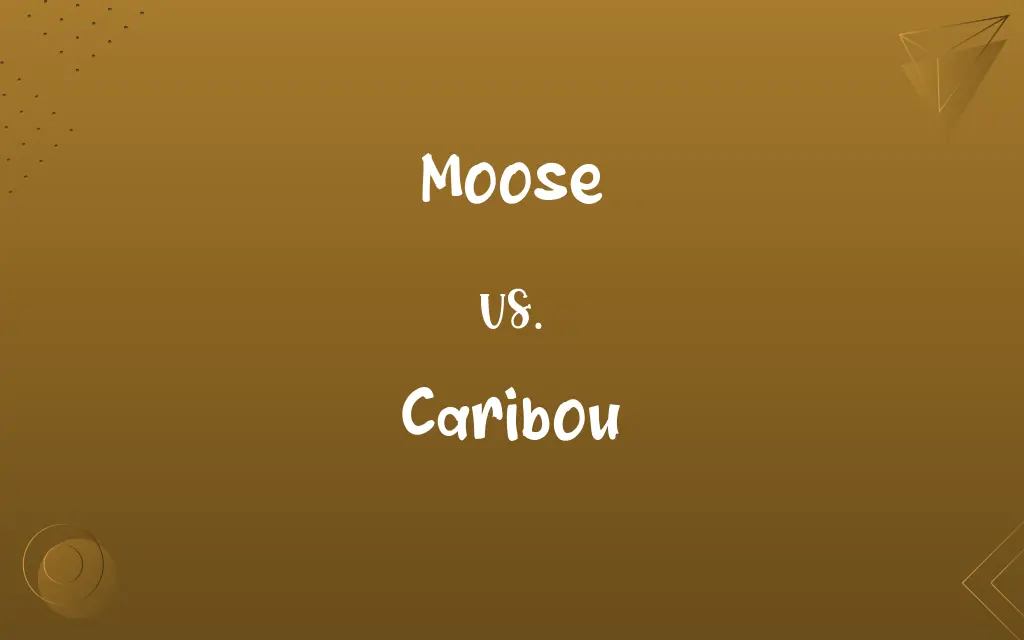Moose vs. Caribou: Know the Difference

By Shumaila Saeed || Updated on December 25, 2023
Moose are large, solitary animals with broad antlers, while Caribou, also known as reindeer, are smaller, herd-oriented, and have branching antlers.

Key Differences
Moose are distinguished by their massive size and broad, palmate antlers, whereas Caribou are smaller with branching, crown-like antlers. Both are members of the deer family but differ significantly in physical characteristics.
Shumaila Saeed
Dec 02, 2023
Moose are primarily found in North American and Eurasian forests, adapting well to colder climates. Caribou, on the other hand, inhabit Arctic and Subarctic regions, showcasing a broader range in colder environments.
Shumaila Saeed
Dec 02, 2023
Moose are known for their solitary nature, rarely forming groups. In contrast, Caribou are highly social and migrate in large herds, traveling vast distances annually.
Shumaila Saeed
Dec 02, 2023
Both Moose and Caribou are herbivores, but their diets differ. Moose prefer browsing on leaves and young branches, while Caribou are adapted to grazing on lichens and mosses, especially in winter.
Shumaila Saeed
Dec 02, 2023
Moose hold a significant place in North American culture, often symbolizing strength and solitude. Caribou, or reindeer, are integral to the cultures of Arctic peoples and are famous worldwide for their association with Christmas folklore.
Shumaila Saeed
Dec 02, 2023
ADVERTISEMENT
Comparison Chart
Size and Build
Larger, with a bulky build
Smaller, with a more slender build
Shumaila Saeed
Dec 02, 2023
Preferred Habitat
Forests in North America and Eurasia
Arctic and Subarctic regions
Shumaila Saeed
Dec 02, 2023
Dietary Preferences
Browsing on leaves and young branches
Grazing on lichens and mosses
Shumaila Saeed
Dec 02, 2023
ADVERTISEMENT
Significance in Culture
Symbol of strength in North America
Integral to Arctic cultures
Shumaila Saeed
Dec 02, 2023
Moose and Caribou Definitions
Moose
An animal known for its solitary nature.
A solitary moose was grazing by the riverside at dawn.
Shumaila Saeed
Nov 26, 2023
Caribou
Adapted to Arctic and Subarctic environments.
Caribou are well-suited to the harsh conditions of the Arctic tundra.
Shumaila Saeed
Nov 26, 2023
Moose
A large, northern deer with broad antlers.
The moose wandered silently through the dense forest.
Shumaila Saeed
Nov 26, 2023
Caribou
A deer species known for its long migrations.
The caribou herd migrated hundreds of miles in search of food.
Shumaila Saeed
Nov 26, 2023
ADVERTISEMENT
Moose
Native to North American and Eurasian forests.
In the remote forests of Canada, moose are a common sight.
Shumaila Saeed
Nov 26, 2023
Caribou
Also known as reindeer in some regions.
In Lapland, the local people herd caribou, which they call reindeer.
Shumaila Saeed
Nov 26, 2023
Moose
The largest species in the deer family.
We spotted a moose near the lake, its antlers towering above the bushes.
Shumaila Saeed
Nov 26, 2023
Caribou
Notable for their branching antlers.
The caribou's antlers were a complex network of branches.
Shumaila Saeed
Nov 26, 2023
Moose
Characterized by its distinctive, broad antlers.
The moose's antlers spread wide, casting an impressive silhouette.
Shumaila Saeed
Nov 26, 2023
Caribou
Integral to the culture of indigenous Arctic peoples.
For the indigenous communities, the caribou is a vital resource.
Shumaila Saeed
Nov 26, 2023
Moose
A large deer (Alces alces) of northern North American and Eurasian forests, having a broad pendulous muzzle, humped shoulders, and large, palmate antlers in the male.
Shumaila Saeed
Oct 19, 2023
Caribou
A large deer (Rangifer tarandus) of the Arctic tundra and northern boreal forests, having large hooves and long branched antlers. Subspecies native to Eurasia are usually called reindeer.
Shumaila Saeed
Oct 19, 2023
Moose
The largest member of the deer family (Alces americanus, sometimes included in Alces alces), of which the male has very large, palmate antlers.
We saw a moose at the edge of the woods.
Shumaila Saeed
Oct 19, 2023
Caribou
Any of several North American subspecies of the reindeer, Rangifer tarandus.
Shumaila Saeed
Oct 19, 2023
Moose
Any of the extinct moose-like deer of the genera Cervalces and Libralces.
Shumaila Saeed
Oct 19, 2023
Caribou
The American reindeer, especially the common or woodland species (Rangifer Caribou).
Shumaila Saeed
Oct 19, 2023
Caribou
Arctic deer with large antlers in both sexes; called reindeer in Eurasia and caribou in North America
Shumaila Saeed
Oct 19, 2023
Moose
A large cervine mammal (Alces alces syn. Alces machlis, syn Alces Americanus), native of the Northern United States and Canada. The adult male is about as large as a horse, and has very large, palmate antlers. It closely resembles the European elk, and by many Zoologists is considered the same species. See Elk.
Shumaila Saeed
Oct 19, 2023
Moose
Large northern deer with enormous flattened antlers in the male; called elk in Europe and moose in North America
Shumaila Saeed
Oct 19, 2023
Repeatedly Asked Queries
Where are moose typically found?
Moose are native to North American and Eurasian forests.
Shumaila Saeed
Dec 02, 2023
What do moose eat?
Moose primarily feed on leaves, twigs, and aquatic vegetation.
Shumaila Saeed
Dec 02, 2023
Do caribou have a social structure?
Yes, caribou are social animals and travel in large herds.
Shumaila Saeed
Dec 02, 2023
What are caribou also known as?
Caribou are also known as reindeer, especially in Europe and Asia.
Shumaila Saeed
Dec 02, 2023
How do caribou adapt to their environment?
Caribou adapt by growing thick coats and hooves that function well on snow and tundra.
Shumaila Saeed
Dec 02, 2023
Are caribou migratory?
Yes, caribou undertake long migrations, traveling hundreds of miles.
Shumaila Saeed
Dec 02, 2023
Can moose swim?
Yes, moose are excellent swimmers and often feed in lakes and rivers.
Shumaila Saeed
Dec 02, 2023
What threats do caribou face?
Caribou face threats from habitat loss, climate change, and predation.
Shumaila Saeed
Dec 02, 2023
How do caribou benefit humans?
Caribou are a source of food, clothing, and tools for indigenous Arctic peoples.
Shumaila Saeed
Dec 02, 2023
How large are moose compared to caribou?
Moose are significantly larger and bulkier than caribou.
Shumaila Saeed
Dec 02, 2023
Are moose fast runners?
Yes, despite their size, moose can run up to 35 mph.
Shumaila Saeed
Dec 02, 2023
What role do caribou play in Arctic ecosystems?
Caribou are key herbivores in Arctic ecosystems, influencing vegetation and preyed upon by predators.
Shumaila Saeed
Dec 02, 2023
How do caribou cope with cold weather?
Caribou have specialized fur and fat layers to insulate against extreme cold.
Shumaila Saeed
Dec 02, 2023
Can moose be domesticated?
Moose are not typically domesticated due to their size and temperament.
Shumaila Saeed
Dec 02, 2023
What is the population status of caribou?
Caribou populations vary, with some herds declining due to environmental changes.
Shumaila Saeed
Dec 02, 2023
Can caribou live in forests?
Caribou prefer open tundra and mountainous regions but can also inhabit boreal forests.
Shumaila Saeed
Dec 02, 2023
What is the lifespan of a moose?
Moose typically live 15-20 years in the wild.
Shumaila Saeed
Dec 02, 2023
Are moose aggressive animals?
Moose can be aggressive, especially during mating season or when protecting their young.
Shumaila Saeed
Dec 02, 2023
Share this page
Link for your blog / website
HTML
Link to share via messenger
About Author
Written by
Shumaila SaeedShumaila Saeed, an expert content creator with 6 years of experience, specializes in distilling complex topics into easily digestible comparisons, shining a light on the nuances that both inform and educate readers with clarity and accuracy.






































































